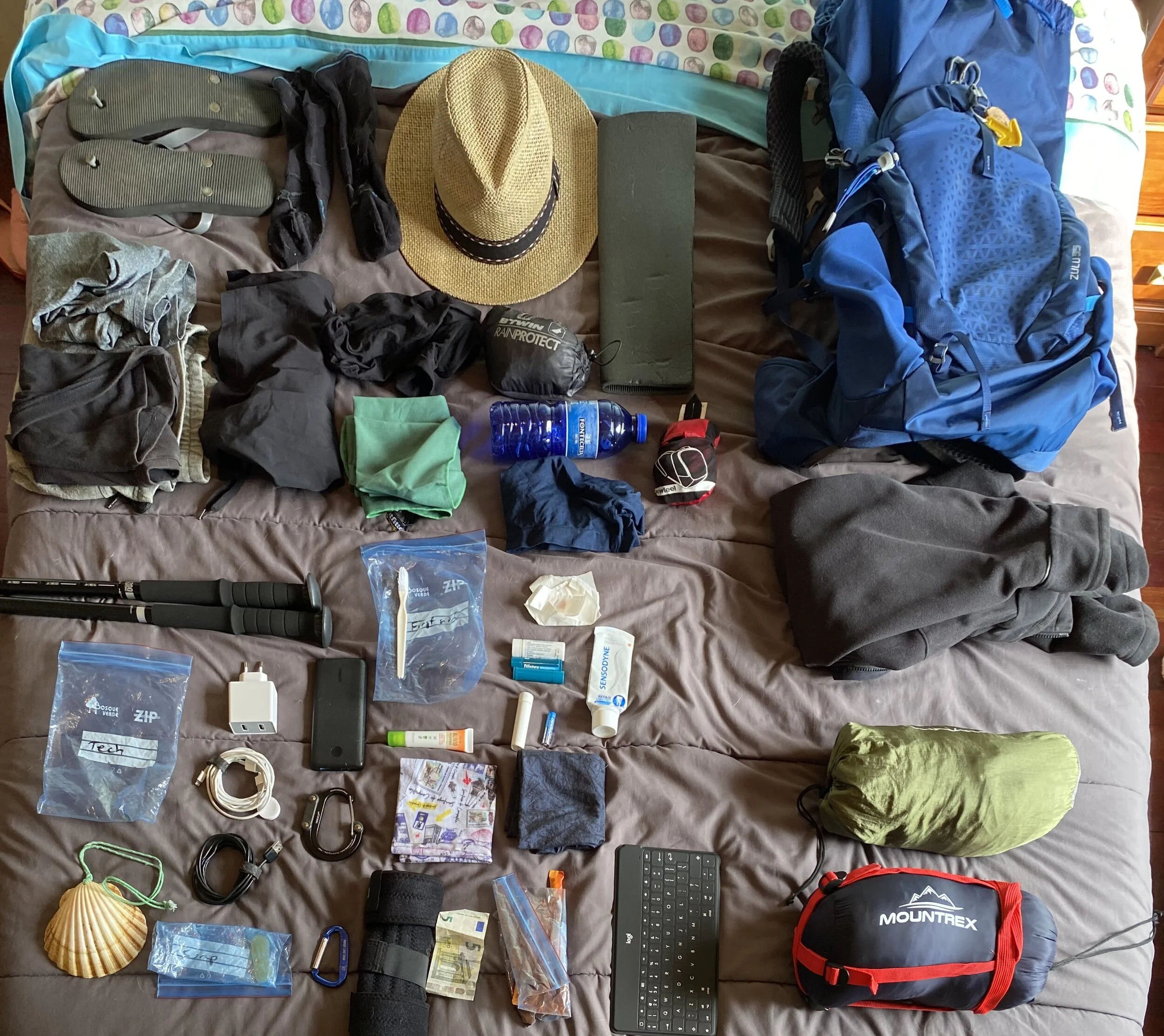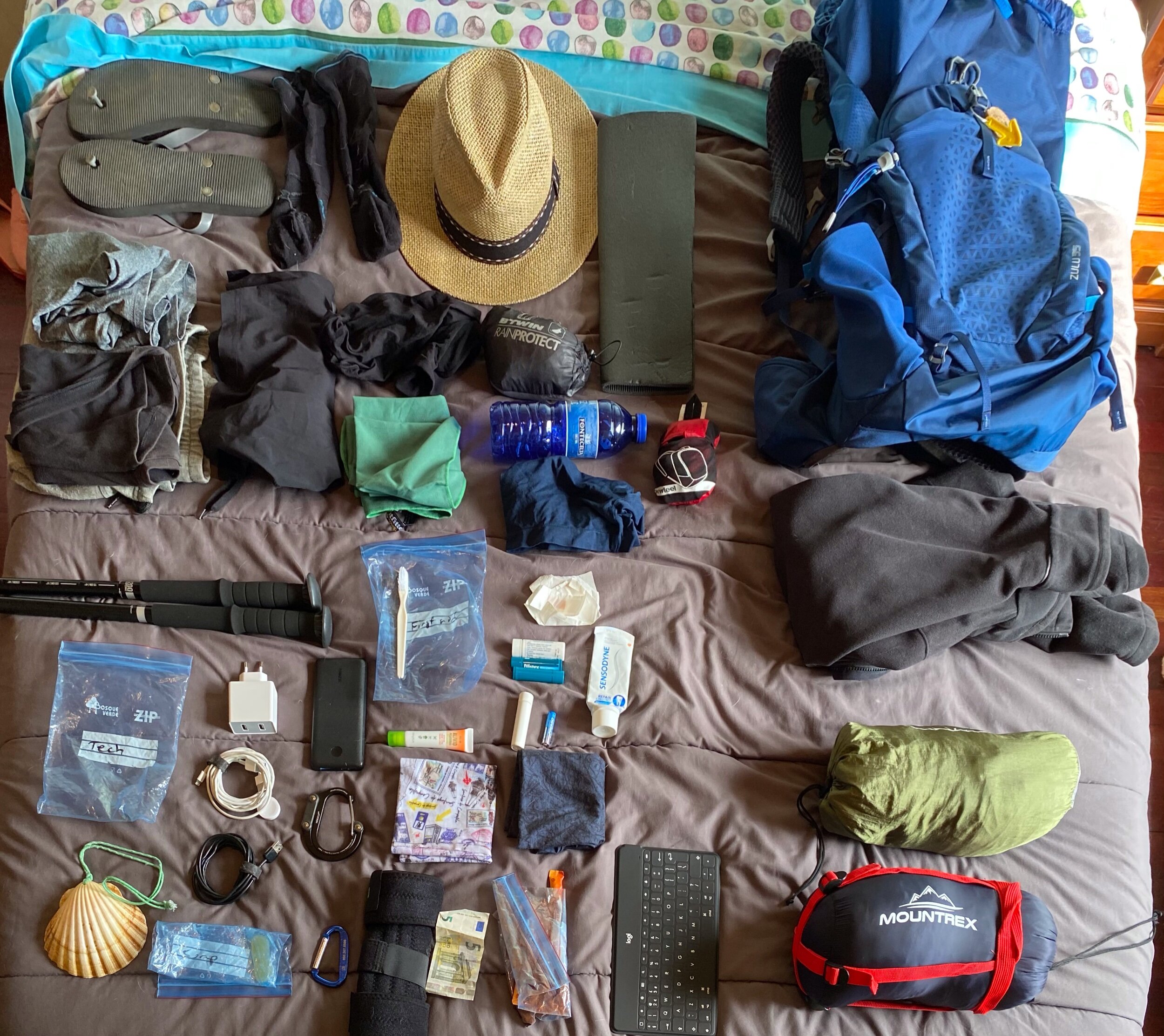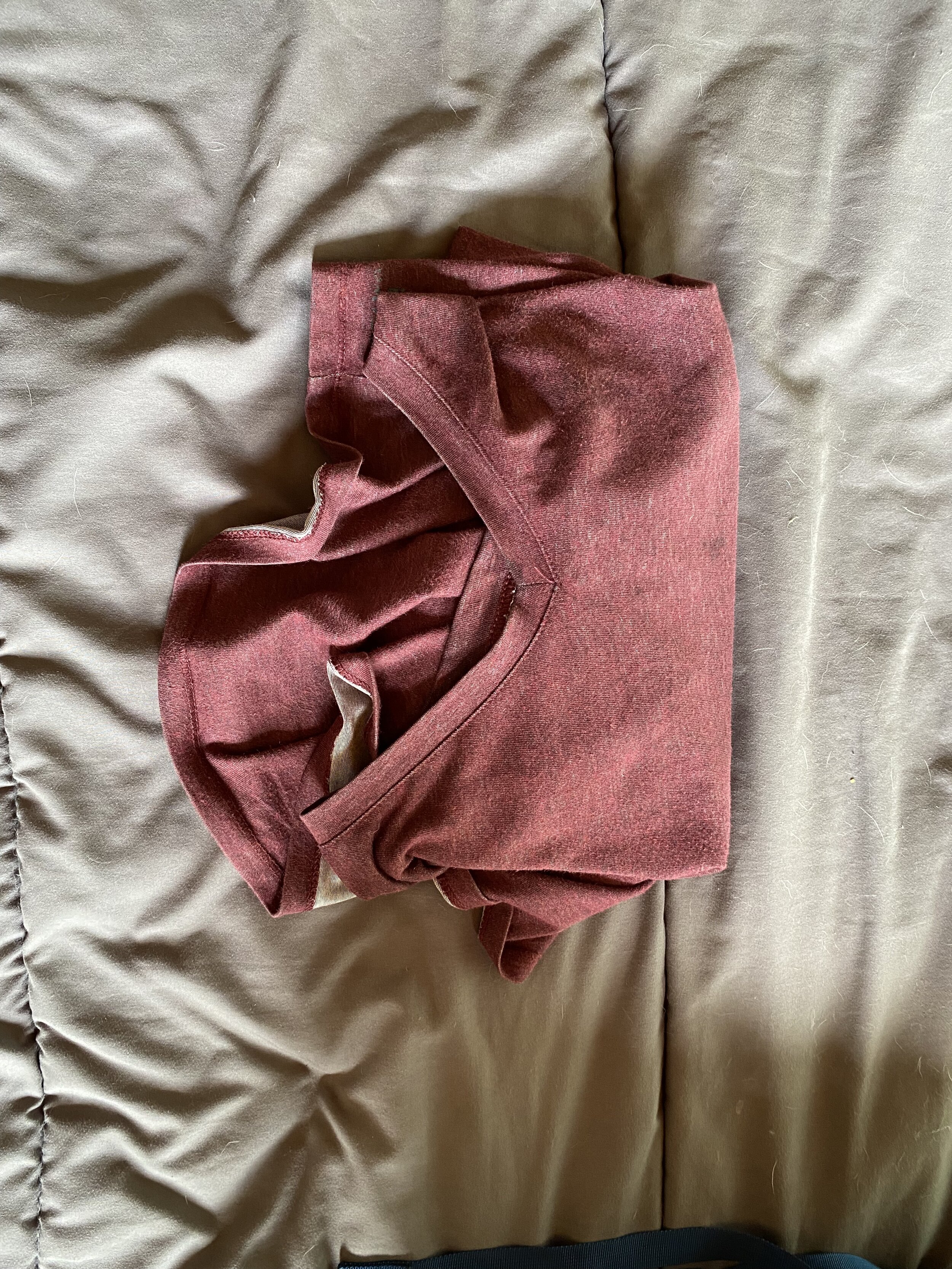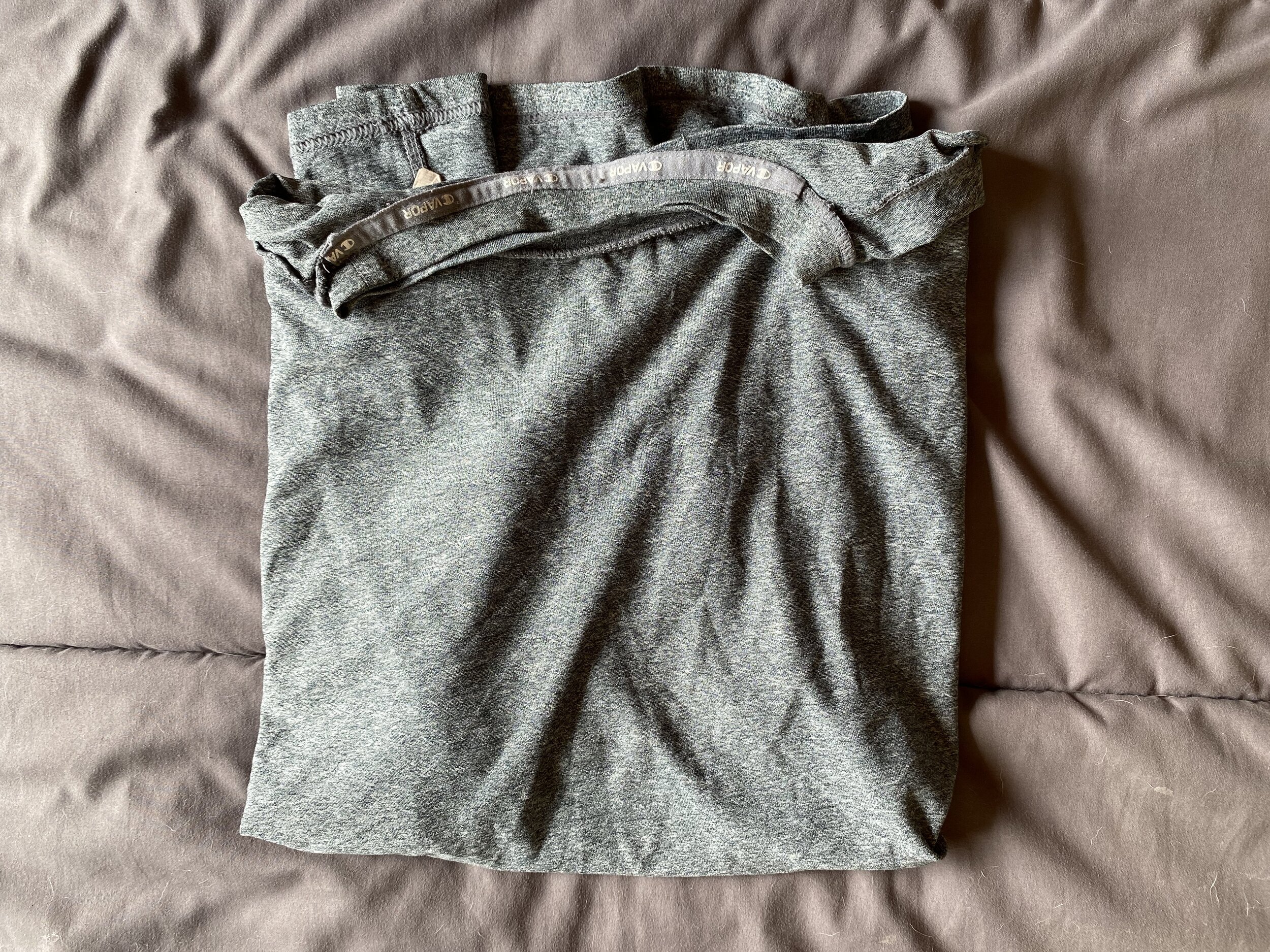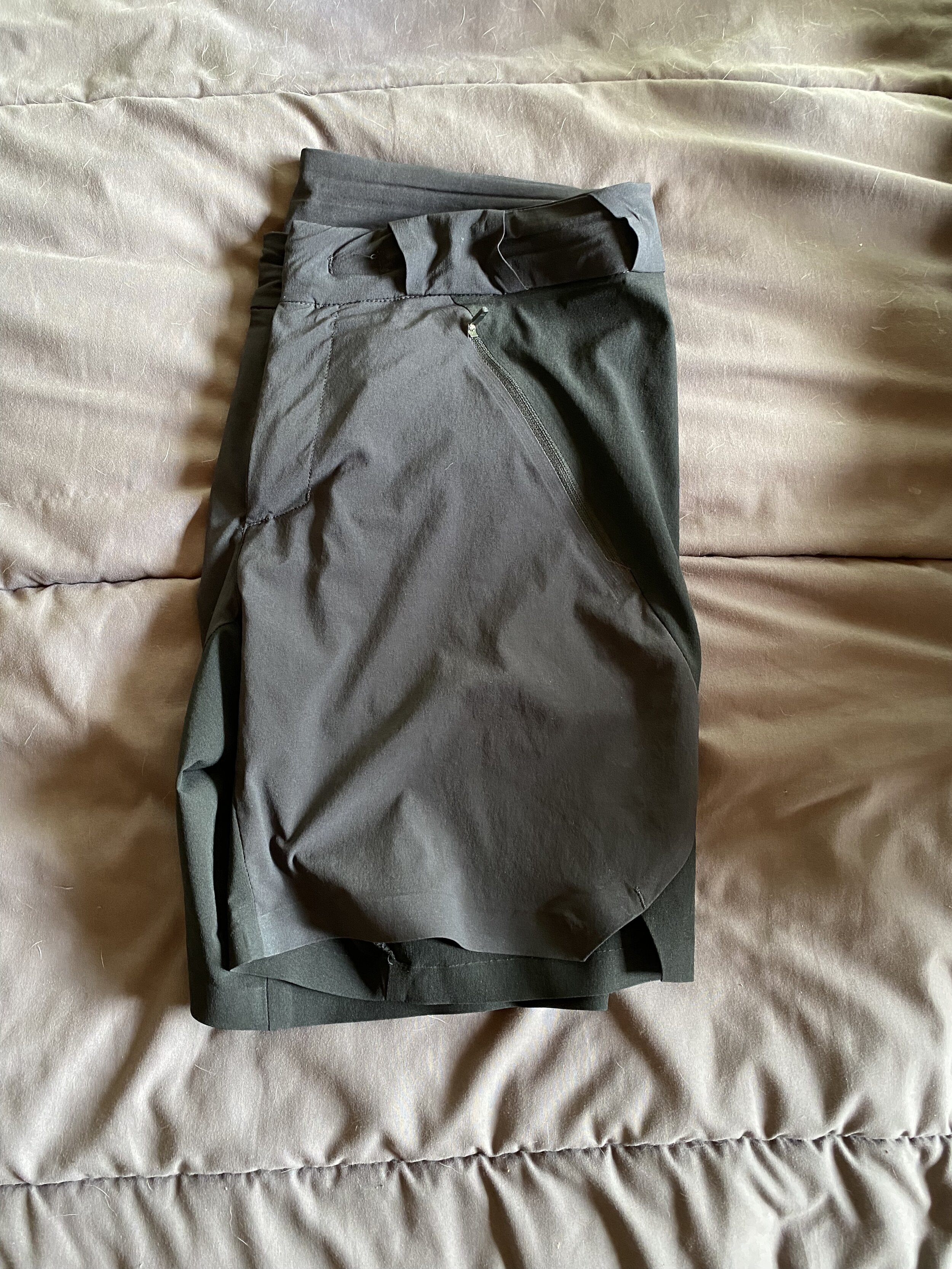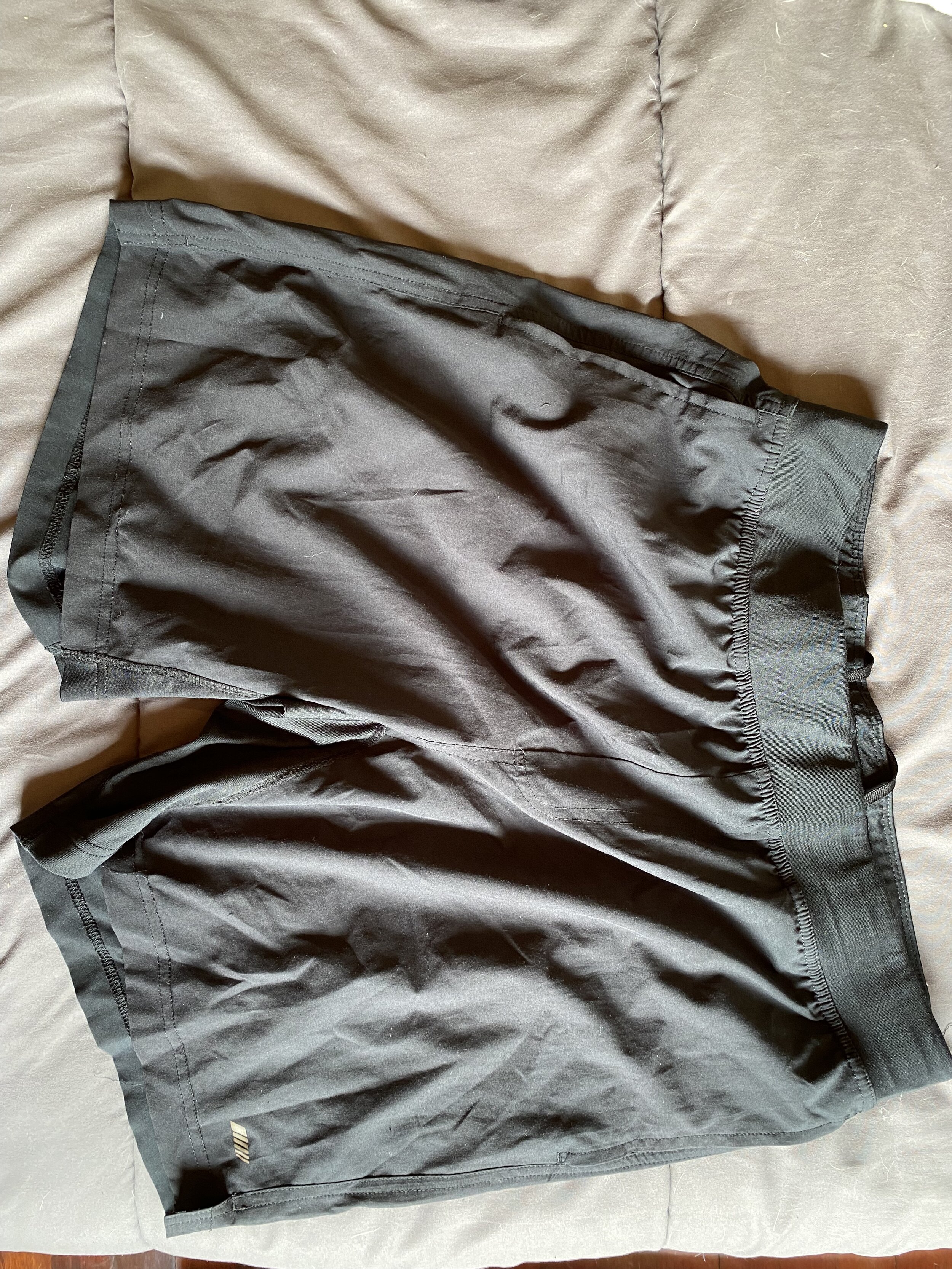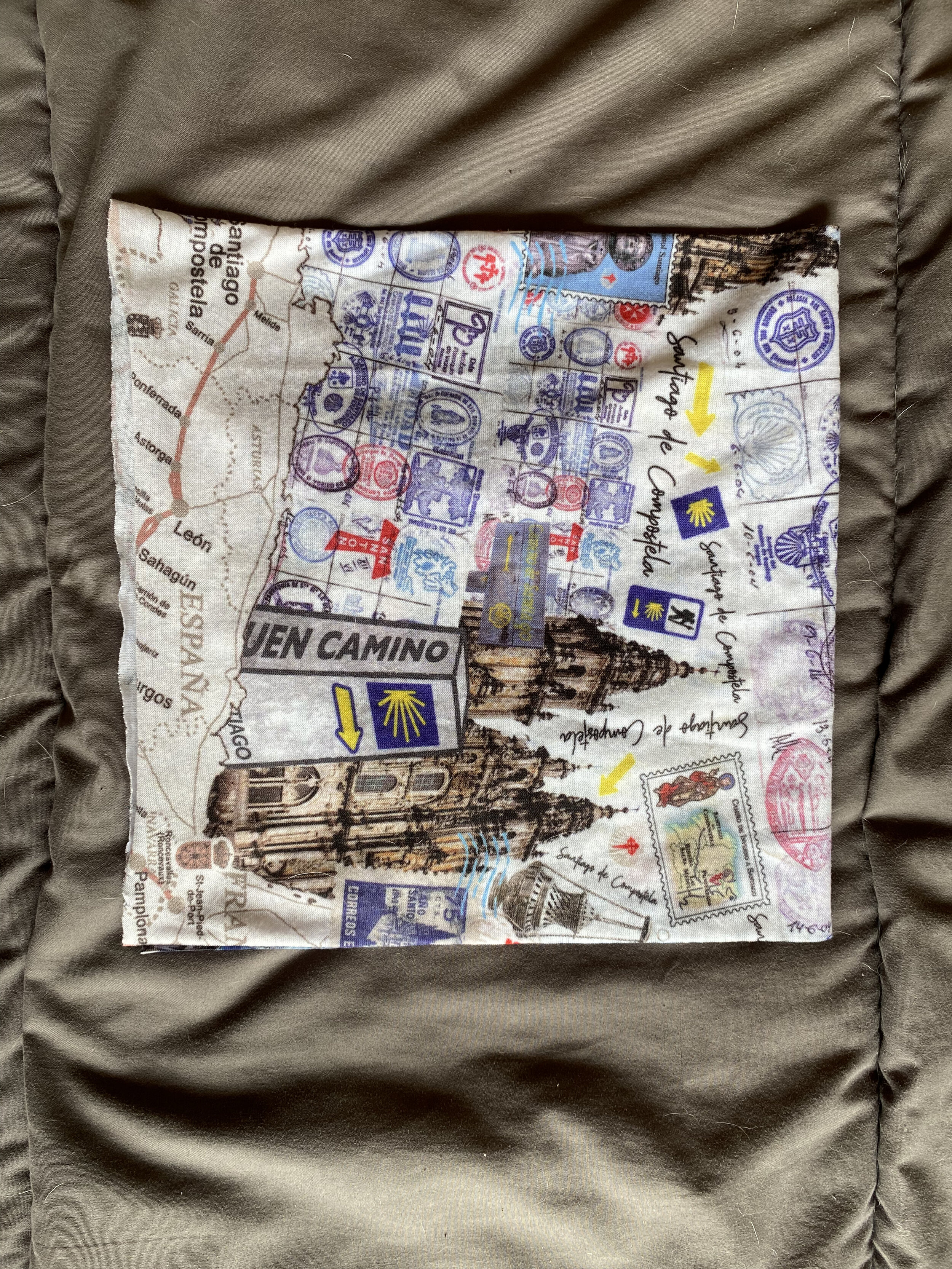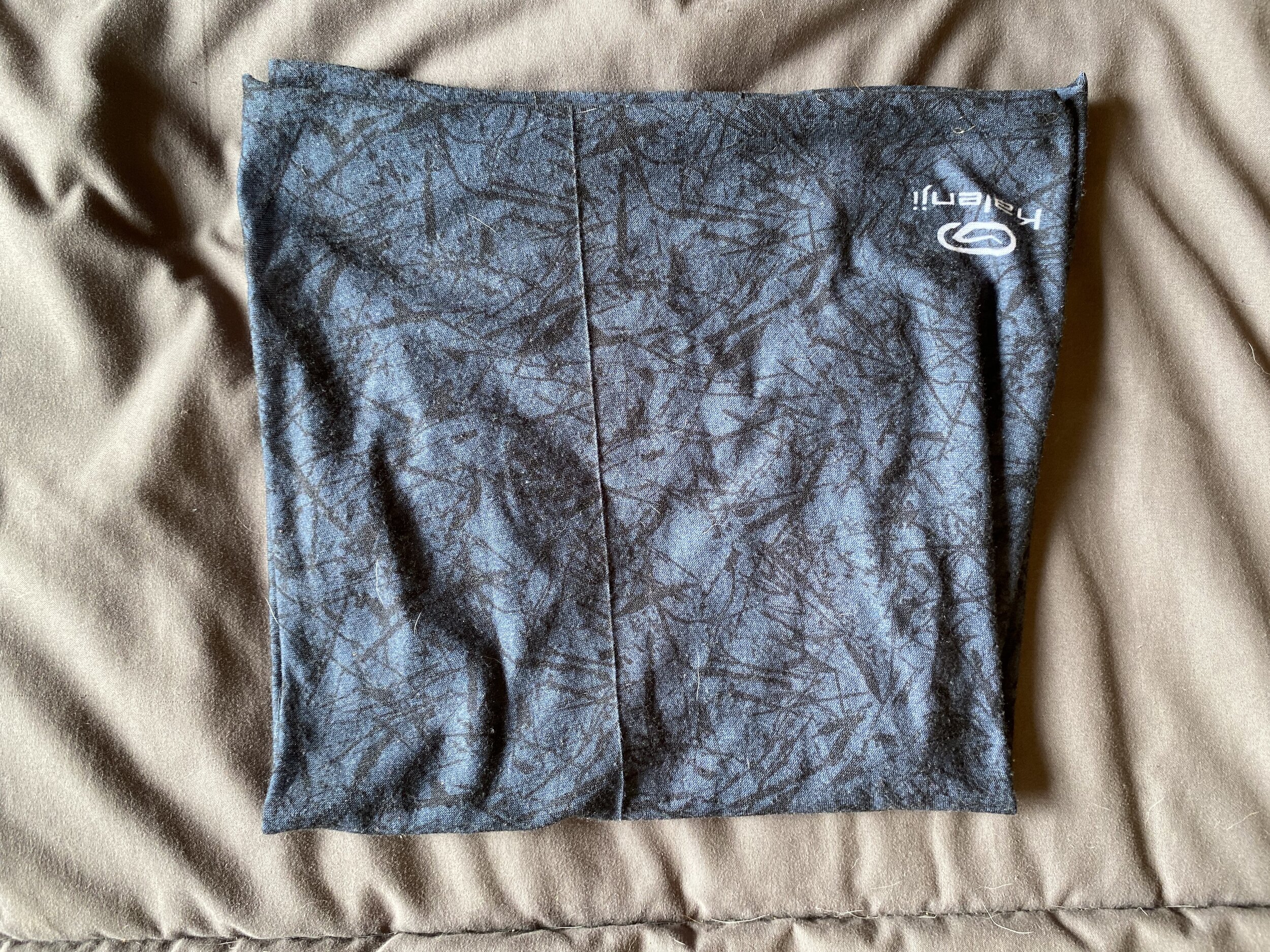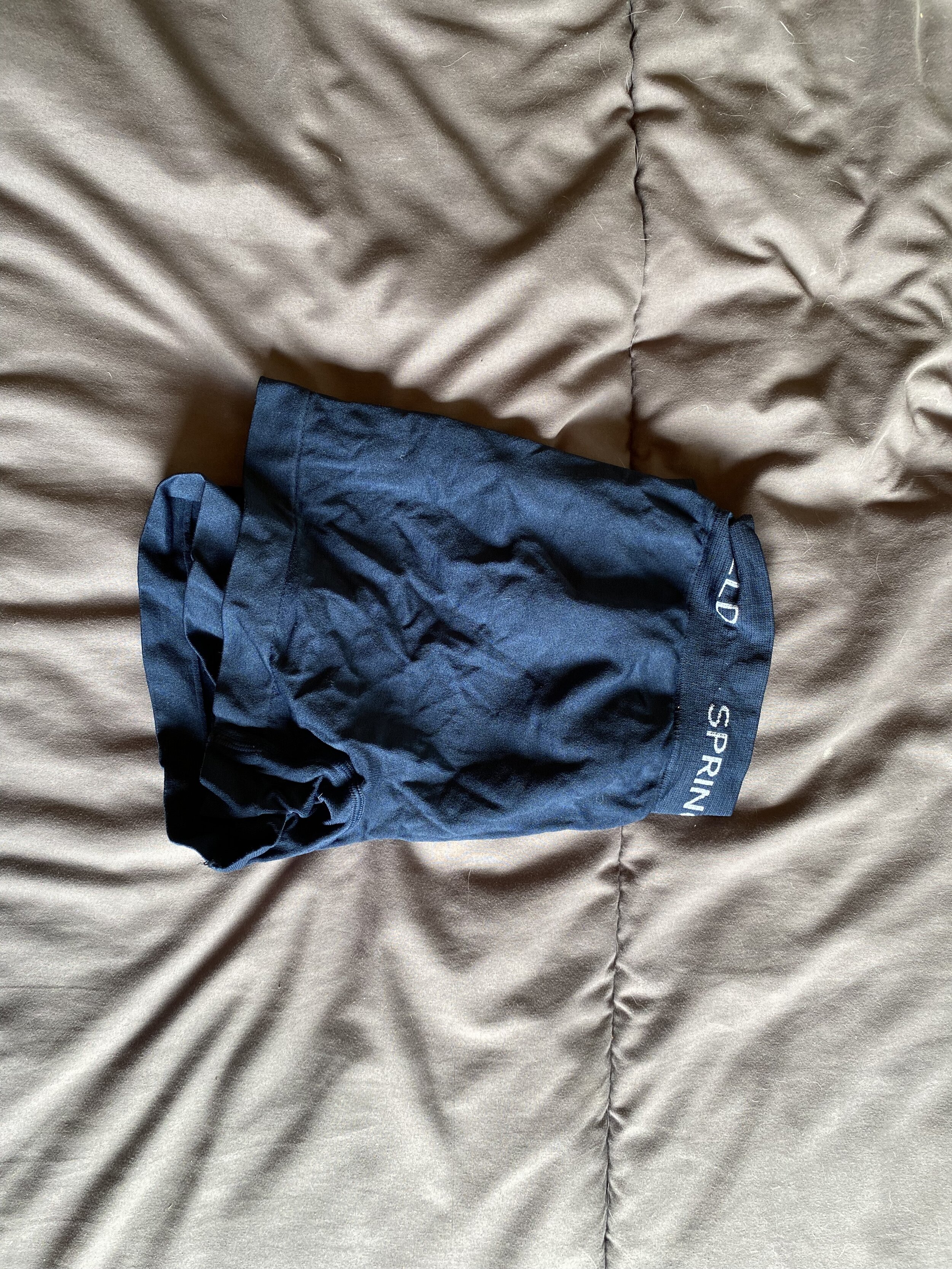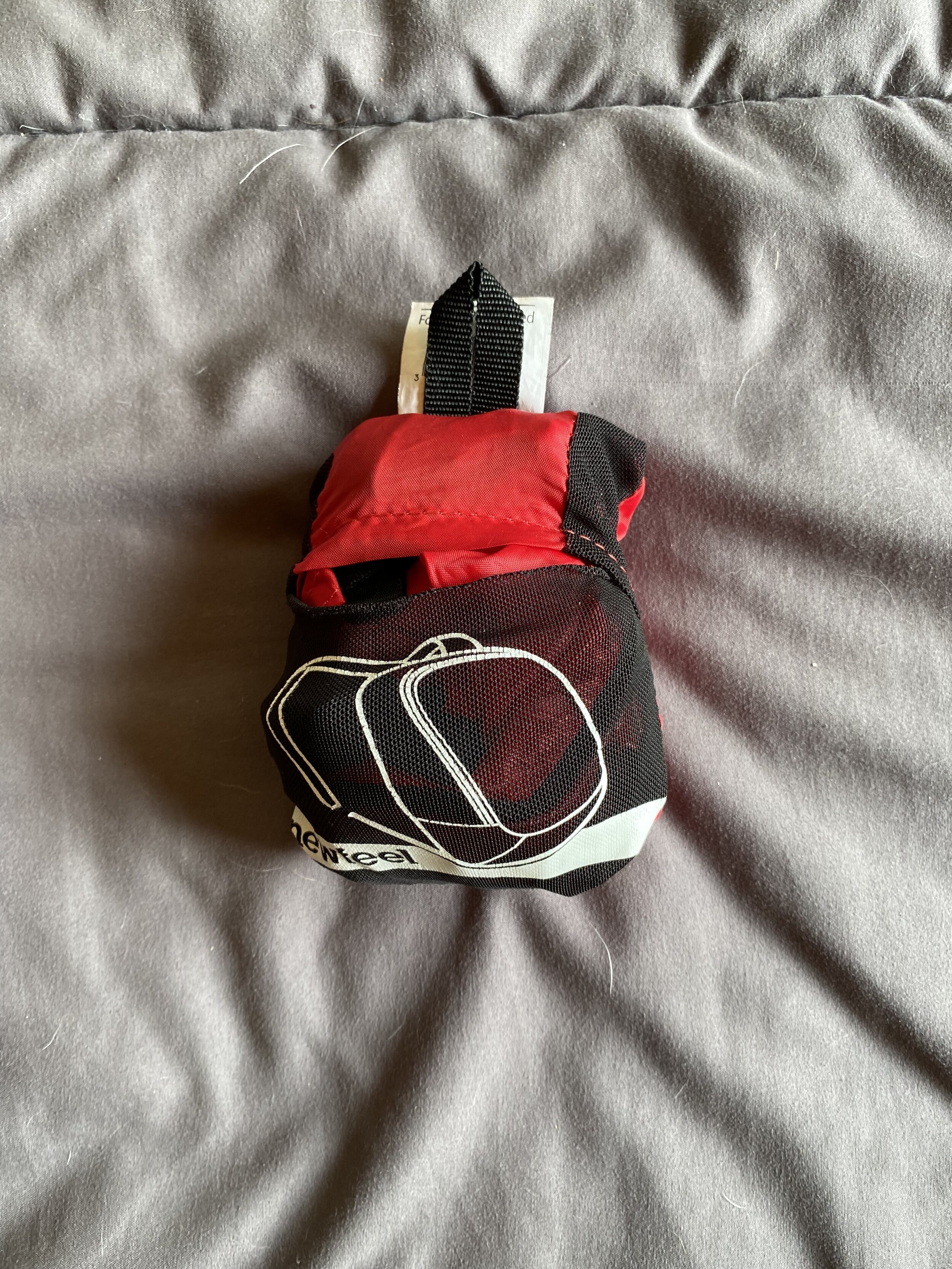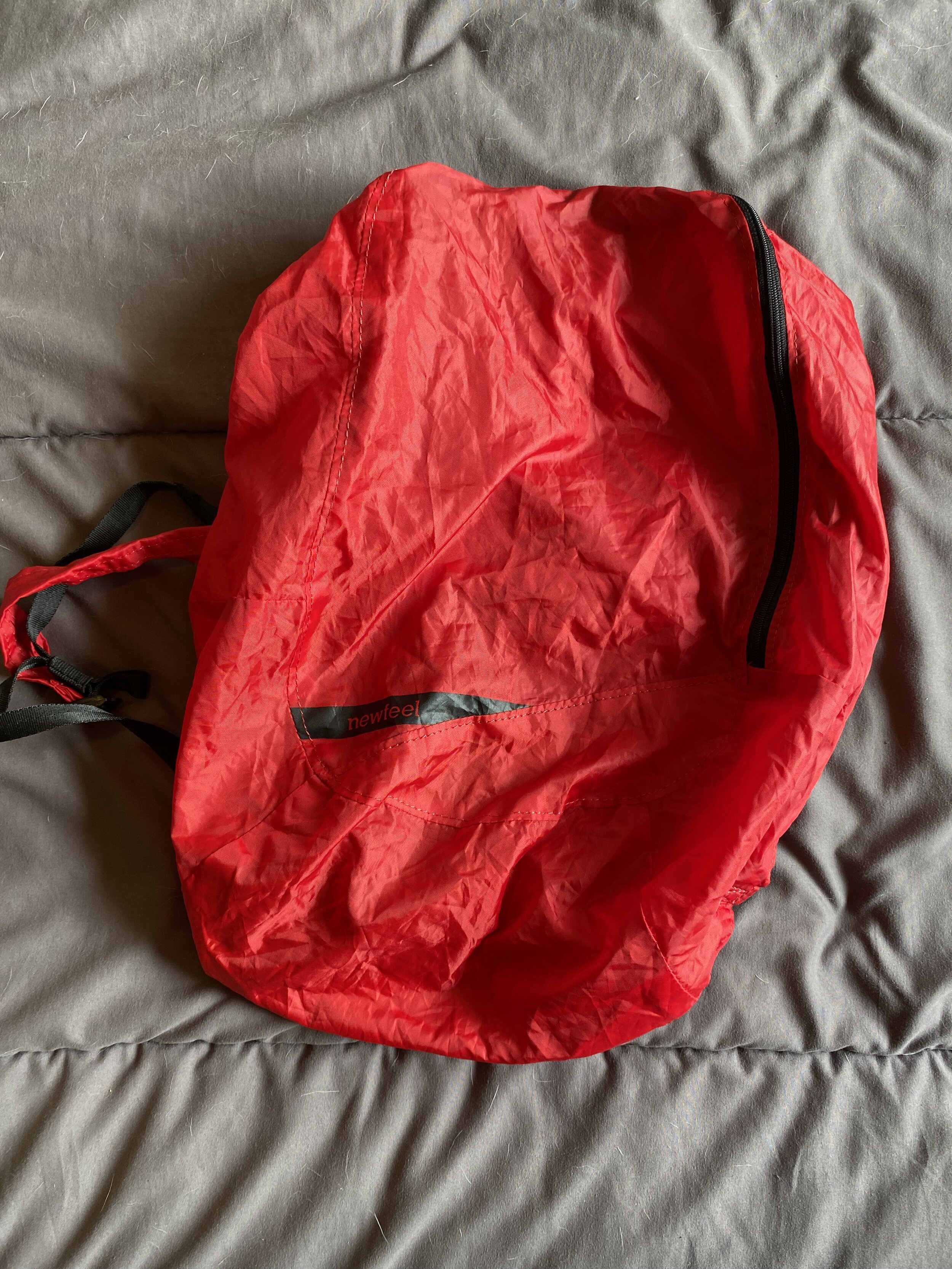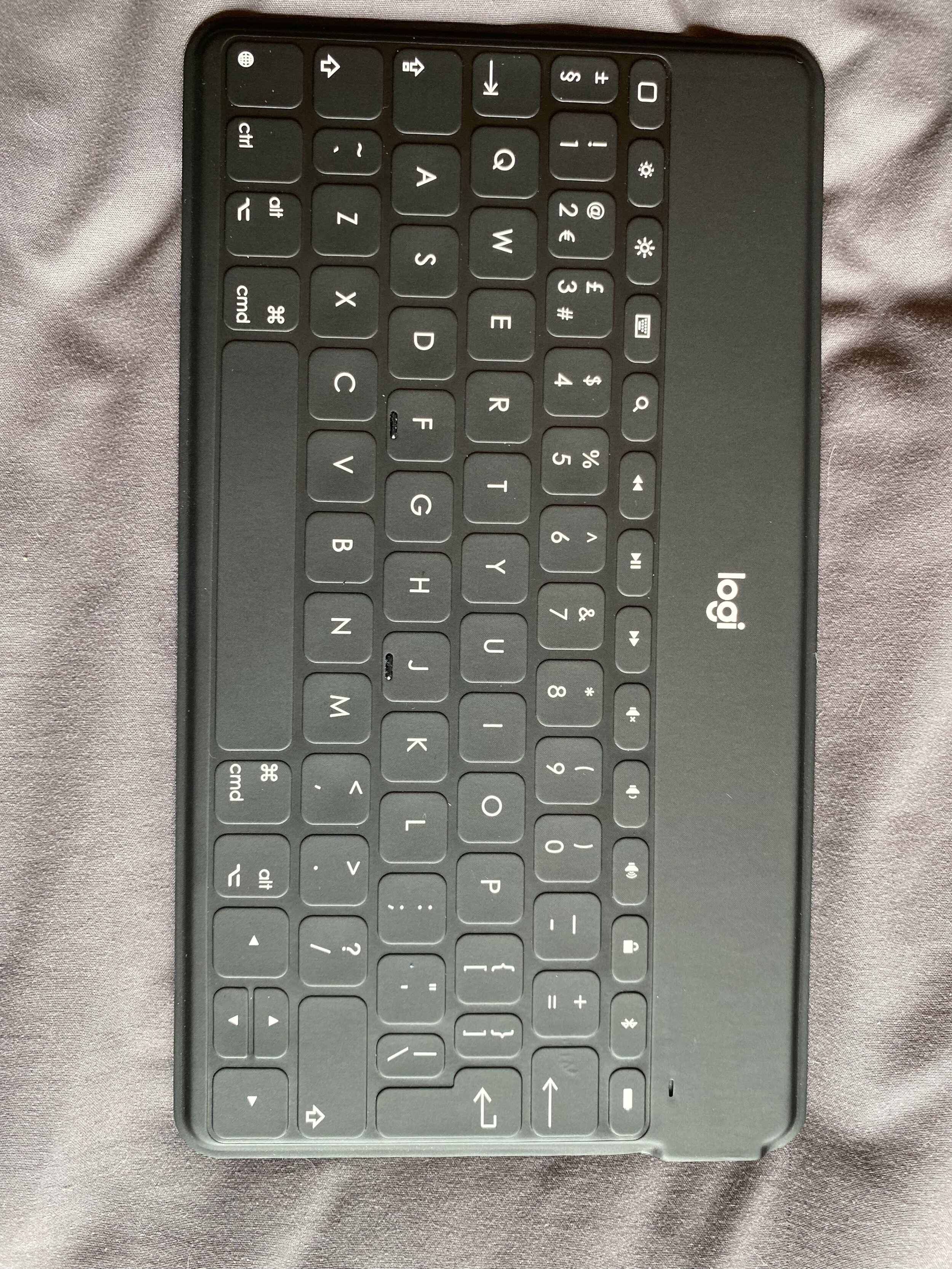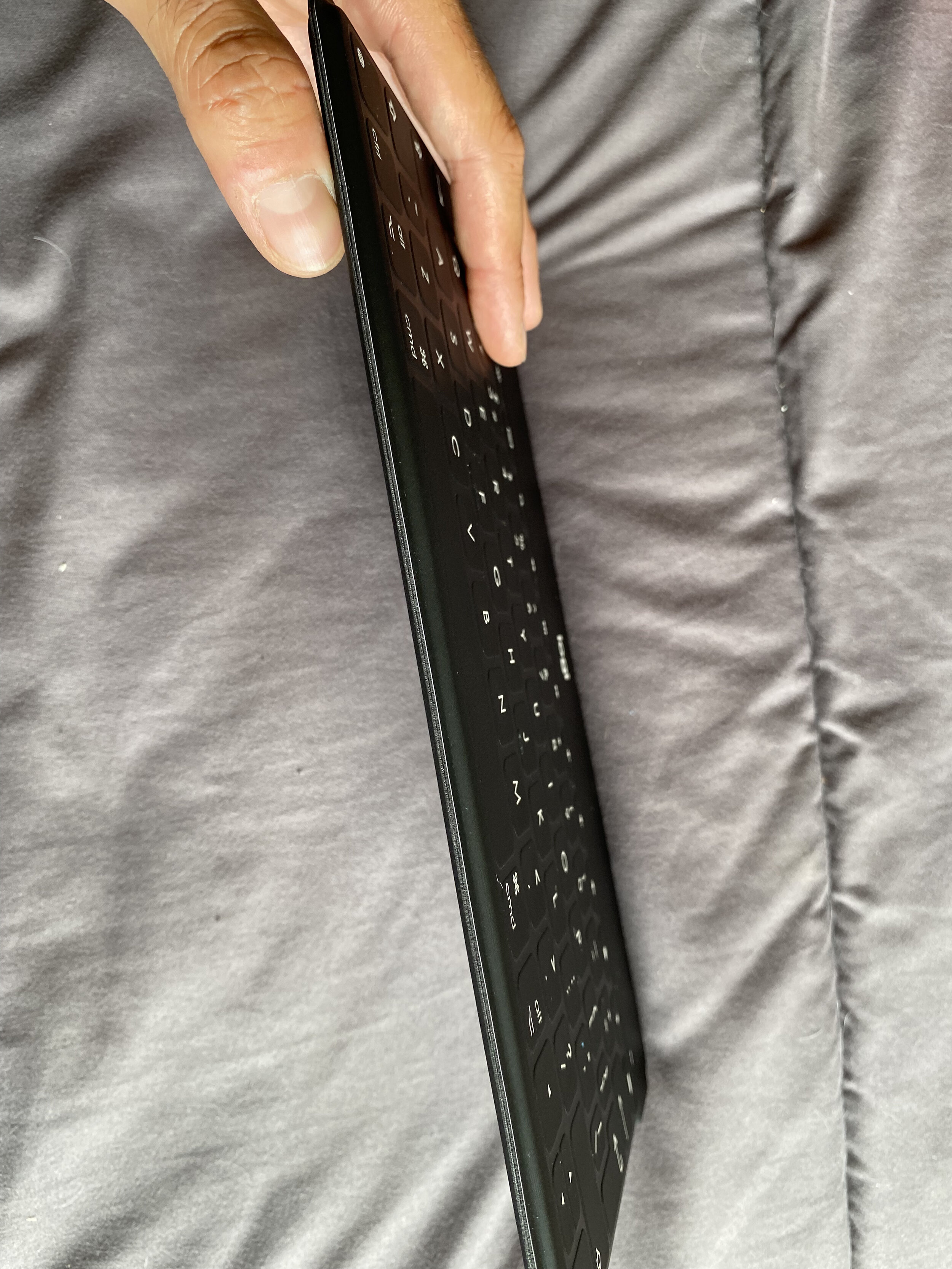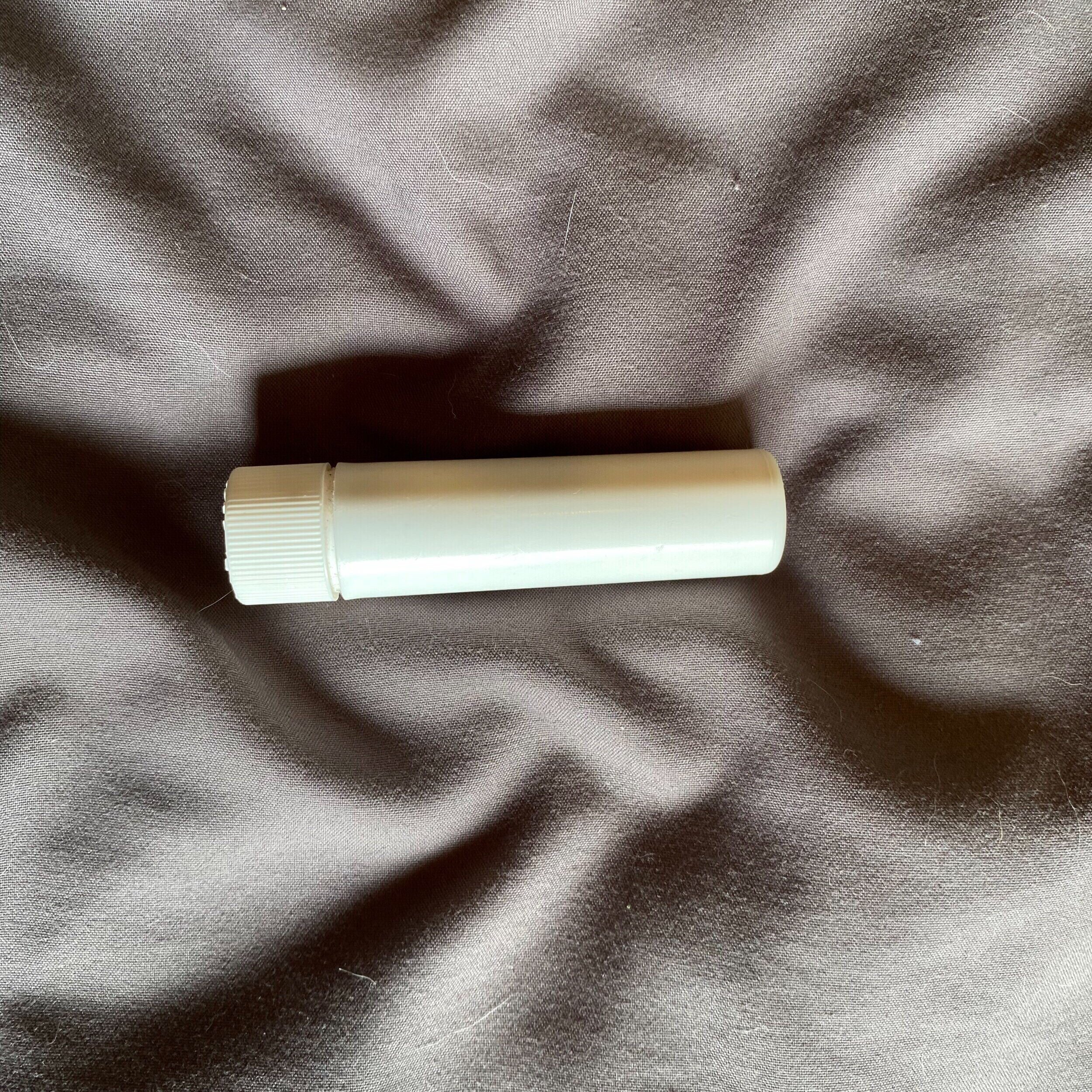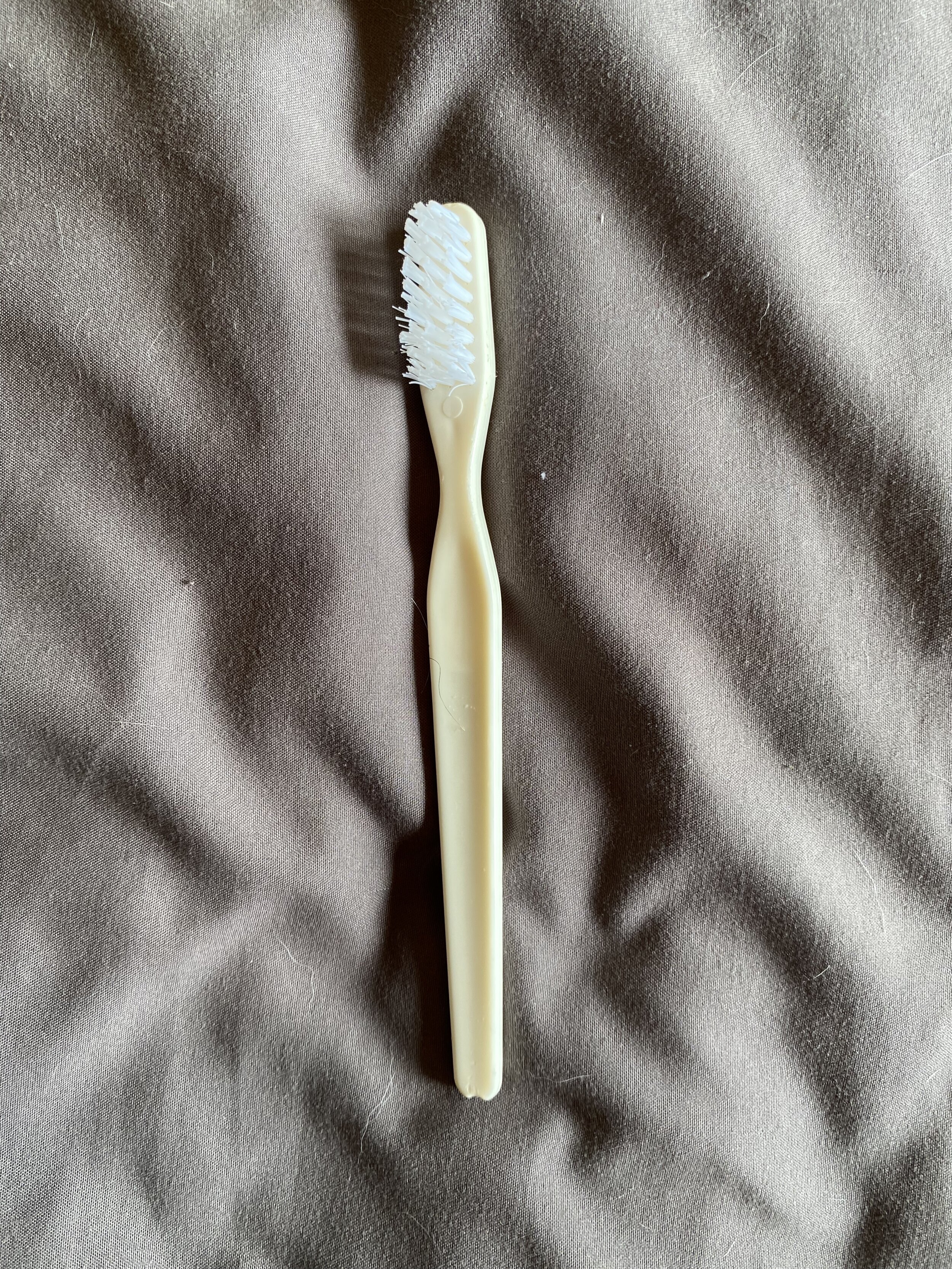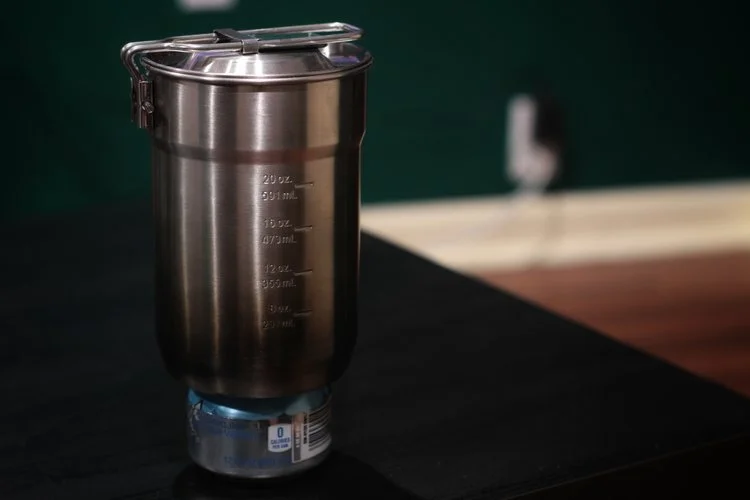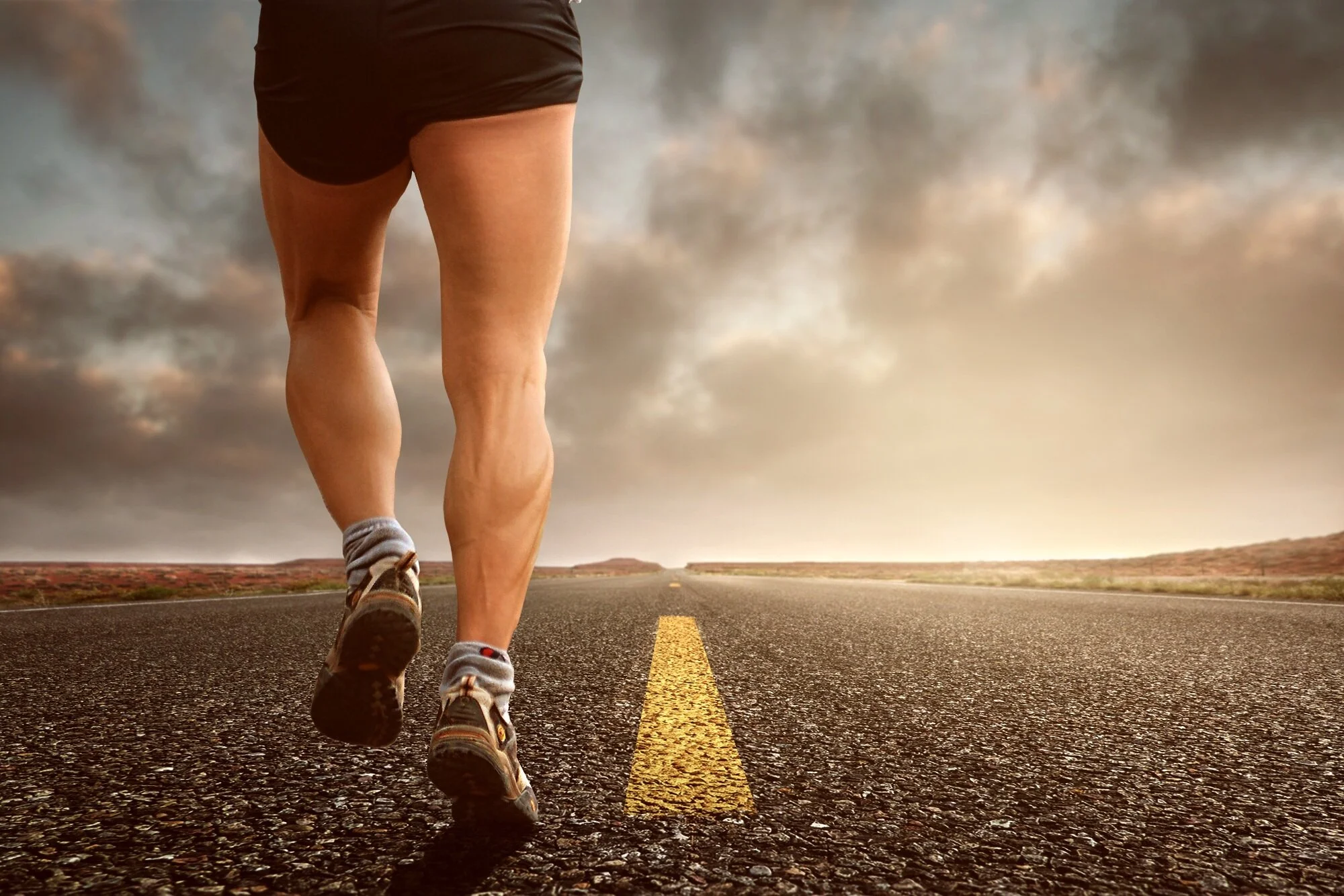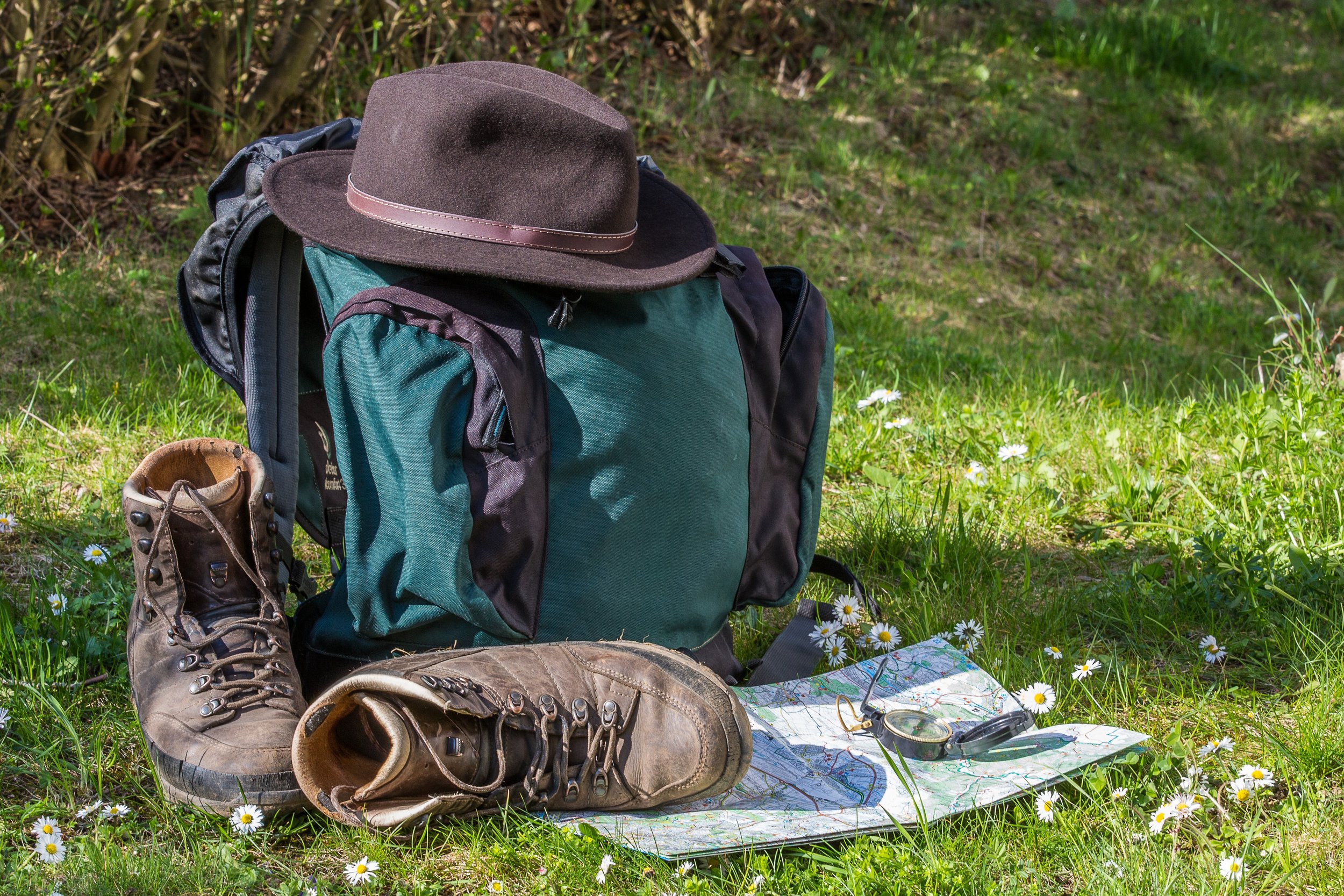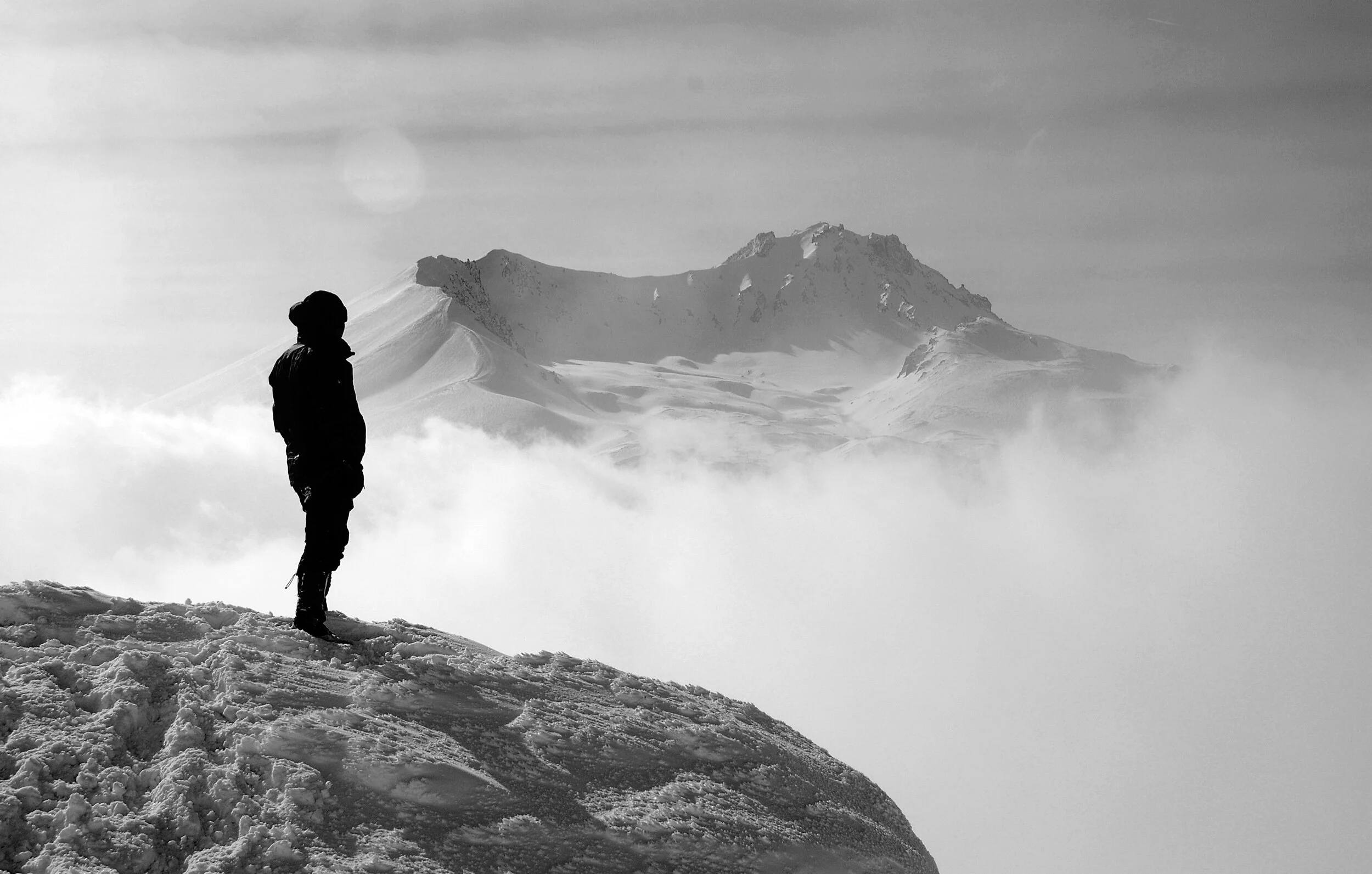My 6-day Summer Camino Packing List with Stealth Camping
Not depicted is my 1 liter nalgene, sunscreen, flashlight, and airpods. These were removed before taking pictures of the gear so I forgot to include them.
It took me days to come up with this packing list. It was a culmination of hour, scratch that, days of youtube videos, reading posts on r/ultralight, and years of thru hiking. The gear wasn't perfect but it sure as hell was satisfying to use.
There is more that I liked about my gear than I hated. I tried to go light and a good indicator that I didn't go light enough is that I didn't need to buy anything. Im going to go through every item I had and tell you how i felt about it, if i would change it, leave it, or if I even used it. Spoiler, I used almost everything I packed out.
I thought really hard about my specific hike to create this list. Its easy to see all these fantastic AT-PCT-CDT hikers and ultralight hikers and start to think “I need to do it that way”. The reality is people travel with different needs and levels of comfort they are willing to tolerate, but also my specific hike was a 6 day urban through hike through Spain in summer and I knew all the weather I was going to encounter. Removing so many variables was valuable and made what I needed to pack more predictable. I just needed to keep reminding myself that I needed to pack for my specific hike.
Besides that I tried to go minimal as possible to reduce pack weight but because my budget was low this didn't always work out. Ill talk about weight, budget, and weather when I get to all the items.
BIG THREE:
Gregory Zulu 35
This bag was bought to replace my old 7 year old 50 liter pack that weighed about 5 pounds (~2.2kg). My idea was if I went down in size, I would save weight.
I started looking at framed packs with good hip support and back ventilation. I went to Gregory’s site just to try a new brand. My osprey packs are great but I heard good things about Gregory and Deutor packs. I ended up liking the zulu pack not realizing its not as “ultralight” as I thought. Something like the Osprey Levity would have been way lighter while being bigger in volume, but in the end I was still saving weight.
I can gladly say I loved the pack. Specifically the harness system. It hugged me so well and never hurt me. No pain at my waist nor my shoulders. I would have liked lashing straps at the bottom just in case I needed to expand the volume but I can do that with some lightweight cordage. I’ll talk more about the bag when I talked about other gear but I can gladly say I loved the pack just for its comfort and also the cool blue color-way.
Montrex Mountrel 100gsm sleeping bag (100g/m)
My sister-in-law, happy to hear I was doing the camino offered me her sleeping bag. Knowing I had one I was ready for the camino. All my purchases were done. Few days before I had to leave she handed me a monstrous sleeping bag.
We are in the middle of the hottest month of the year and she hands me a 35liter sized sleeping bag. How did I know it was 35 liters? Because it was the only thing that could fit in my 35 liter zulu. It took up most of the space in the 50 liter pack. This wasn't going to work. Amazon, help me.
Thats when I found the Montrex bag. It was lightweight and small. Perfect for the summer. The site says its good for 20c all the way down to 10c. It even packed down small. Perfect summer sleeping bag.
Why did I bring a sleeping bag? Well I had two thought processes here, the first, was to use it in albergues if they didn't have blankets. It would also act like a sleeping bag liner and protect me from the disgusting sheets of the albergues. It had a synthetic fill so washing would be easy if it got bed bugs or something.
My second thought was, since I would be walking without a plan, I wanted to be prepared if there wasn't any albergues available. I wanted to ability to sleep outside or stealth camp if necessary. Night temperatures got as low as 14c so this light sleeping bag would do the trick.
Overmont hammock (with bug-net but no shelter)
What would be the best shelter in the middle of summer, no chance of rain, and in a wooded area. Well a hammock of course. I was familiar with the area so I knew stealth camping would be in forests, which there were plenty of.
Hammock would be quick to set up and super comfortable. It was definitely super comfortable. The problem with this particular hammock is that, while it was cheap and seems very durable, it was also very heavy. Coming in at around 1.3 kg without a tarp. This increased my pack weight greatly. On my hike I had been doing research and found alternative tree straps that weighed 45g instead of the 300g straps that came with the tarp. In the future though I might buy a lighter hammock with tarp.
One issue I had with the hammock that I thought wouldn't be that much of an issue is the draft underneath. Usually a hammock is insulated with an under-quilt or maybe some sort of insulating barrier like a sleeping pad. I figured my sleeping bag would sort this out as it would only get to 14 degrees on the coldest night. I was wrong.
My first night was very cold. It was a weird sensation. I was sweating wearing my jacket and “thermal underwear” but my back and body was cold and I was shivering. The sleeping bag wasn't insulating me well because it was being compressed which reduces its insulating properties. Even with a descent sleeping bag it probably wouldn’t be enough insulation.
Its not like sleeping on the floor or couch. When you lay down on something cold like a cold couch, you heat is zapped temporarily until the area underneath you gets to the same temperature as you. Then the couch acts as an insulator trapping the heat between you and the couch. Get up and your dog takes your spot because the couch is still warm from your body. Other surfaces like dirt have the capacity to absorb more heat but putting down an insulating barrier like dry leaves or a sleeping pad remedies this.
Hammock on the other hand is see-through thin. That fabric can’t hold much heat. The wind is constantly moving underneath the hammock zapping your heat and moving along so that more heat zapping wind can come and kill you softly inside as you eat your bread that you have been eating all day because you hadn’t seen a supermarket all day and your only eating it to try and keep warm but it’s getting hard to swallow and your moral is low and your feet... you get the point. What happens is it keeps cooling you and the fabric never letting it get warm, zapping all your heat. Your legs can be warm on top and sweating but you can be shivering from how cold you are.
My first night was like this. All my clothes on and inside my sleeping bag. I slept fine once I was completely inside the sleeping bag with it zippered closed.
The second day I wised up and used my towel to cover the bottom of the hammock and my sit pad to insulate my torso. The sit pad worked beautifully, the towel not so much. I slept better that night.
The hammock was multi-use. It was my clothes hanger at night. I would stuff my socks into the loops of the tree straps. The cordage used for the bug net could have been used to create a clothes line in a albergue if needed, but all of them had a place to hang clothes.
Honestly, I slept well every night in the hammock. Something about looking up into the might sky, listening to the acorns fall, crickets chirp, or the sound of the ricer was so relaxing. I slept better in the hammock than any other night. I just wish i had a sleeping pad to put in the hammock.
CLOTHES:
2 hiking socks
Love my double layer hiking socks. They have a sock liner type inside to prevent blisters. I got one blister on this trip and it was the first blister I ever got with these socks. Durable too. Iv had this pair for 7 years. Wouldn't trade them.
One downside is that they are made from cotton. Two issues there. The first is they might start to smell quicker than wool socks. Thats not a big deal.
The second is they dry really slow. The double layer coupled with the cotton material means they take all day to dry in the mesh pocket of my pack. Even overnight they wont dry completely. This slow drying can be an issue when your feet start to sweat which can promote the chances of getting blisters.
2 hiking shirts
Nothing much to say here. One shirt looks like a hiking polyester hiking shirt while the other is a nicer v-neck shirt I can wear with my town shorts. I actually wore this shirt with my town shorts and my pack while getting on the train and overheard someone say “Is he going to hike on those clothes?”.
I enjoy the polyester hiking shirts because they are a near perfect hiking shirt. The quickest drying of all the hiking shirts, excellent moisture wicking properties, durable AF, and cheap, like $5 cheap. But they have one weakness that isn't that big of a deal on a wilderness hike but on the camino it does bother me and that it starts to smell quick. Within a couple hours I can already smell the start of a dirty shirt. And the shirt can get to a quite disgusting level of smell. But because of its quick drying nature I can wash them and hang overnight for a clean shirt the next day.
1 hiking tank top
Will let me get a tan and sunburn. I like hiking in a tank top and gives me an extra hiking shirt.
2 hiking shorts
These are nylon hiking shorts. Lightweight and breathable. They have pockets which i use for my mask and phone.
1 town shorts
I wrote an article about the camino and it emphasized why you should have a pair of town clothes. Town clothes are also good for when your clothes are drying. One pair of lightweight shorts is not that much of a weight penalty.
Stockings
Lightweight and warm as hell. Yes, I wore stocking, but only to sleep. Perfect lightweight leggings for the summer.
Fleece jacket
I use fleece over one of the puffy jackets because im a cheap fuck. The fleece is about 2-3 times as heavier than a puffy jacket of the same warmth, but I have had this fleece for about 6 years, worn it as my main jacket in the winter, used it for all my through hikes, and it still like new.
The fleece, while being heavier, also doesnt pack well. It remains bulky and larger when stuffed. This ends up being a good thing in my case. Remember how i mentioned that the sleeping bag compressed when laid upon which ended up reducing its insulating properties? Well fleece doesn't suffer from that.
Also the fleece cost me 40$ for a name brand one. You can’t beat that.
Wide brim hat
I prefer wide brimmed hats over caps. The cap only protects your face from the sun overhead. A wide brimmed hat protects you at greater angles. Its my favorite piece of gear. The bigger and goofier the better.
Buff
A buff can be used in so many ways but i ended up using it as a sweat rag. I ran it through some shock cord that was on one of my shoulder straps. Im not going to lie, it got pretty gross. I might buy a antimicrobial merino wool one on the future.
Update: I ended up buying another one at the end of my hike as a souvenir. I like the idea of having two; one like a bandana and the other as a buff.
Hiking boots
I usually wear trail runners but this year i bought some boots and were testing them out. Originally I bought the boots for the camino primitivo because I wanted the ankle support.
Underwear (1)
To wear with my town shorts. Some quick drying ones. Nothing special.
Rain gear
I looked up the weather before I left and it said sunny until the foreseeable future so I packed light in terms of rain gear. Pack cover and the only rain jacket I have. This is a pretty good rain jacket. It folds into itself and and is super light. So light that the fabric is see through. I figured this was enough just in case it rained or as a shell layer for cold windy days.
And then I had to extend my hike with a chance of thunderstorms…
TECH:
Apple watch
Originally I wanted to use my Casio hiking watch but i left it at my apartment. The apple watch was a little bit of a hassle because I had to charge it everyday. It did record the information for my hikes which is nice. Also the watch was a good alarm for the albergues as it would only vibrate and not wake up other pilgrims.
A watch was a must since I time my breaks and Its important to know the time while racing to get a bed in an albergue.
Iphone
Map, looking up places to eat, reserving albergues, messaging friends, girlfriend, and family, taking pictures, etc
Anker 10,000 slim battery bank
I was happy with this battery. It was relatively light and was able to charge my iphone and apple watch two times completely. No complaints. Would not go bigger but could possibly go smaller.
Lighting cable
To charge my iphone and airpods. Its a 6 foot cable so I can use the phone comfortably in bed.
Usb-c cable
To charge the external battery bank.
Dual usb charger
When looking up videos on what to pack I found that most people focused more on the battery pack in their tech loadout. They would pull from their tech pouch a 200,000 watt hour external battery and proceed to talk about it for 15 minutes on how its the perfect battery for them. This rant is probably to justify carrying this heavy device just to charge their phone every once in a while. They would then move onto their cables and lastly a small charger they probably got with their phone, cable still attached.
I never understood this. Battery pack is just a device that will charge your phone ‘if you need to’ but a charger will charge your phone because you ‘have to’. I prefer to be able to get to an outlet and start charging everything as quickly as possible. Large battery packs take time to charge and with the additional tech I was carrying, I would need something better than a small phone charger.
I actually wanted a charger with more usb ports. I had my headphones, iphone, battery, and watch to charge. The battery if charged had to be plugged in overnight which left me with one port. Having 3-4 ports would have been a luxury.
I dont mind leaving my battery pack to charge in the albergue since it cost me $25 but my phone and watch I would prefer to charge quickly when I get to the albergue so I can leave and go eat dinner or do other things. Quick charging and multi port charger is critical for my needs.
Apple watch cable
Another reason I didn't want to bring the apple watch. This cable is extra weight and takes away from the usb slots in my charger brick.
Sandwich Ziplock bag, 2
These things weigh 6 grams! I only had three. One for tech, another for soap, and the other for hygiene, repair, and first aid. Tried to consolidate as much as possible. The soap needed to be separate because it got pretty gross.
Airpods
Light, easy to use, and bluetooth. Their battery life is compensated by their charge time. They work and don’t feel the need to bring anything else.
Flashlight, fenix E05
Wanted a flashlight because I knew I would be setting up my hammock near nighttime. I didn't want to buy a new headlamp so I just used the flashlight I have. A very nice flashlight by the way.
Has a paracord leash which brings it up to the weight of a really light headlamp.
Definitely would like a usb-c charged headlamp in the future.
MISC:
Microfiber cleaning cloth
Because I wear glasses.
Medium size microfiber towel
Sometimes albergues don’t provide towels. These microfiber ones dry quick. I keep this in the mesh pocket on the outside of my bag. It’s just big enough to wrap around my waist and to use to lay down on with my legs hanging over.
Trekking poles, decathalon brand, aluminum
The aluminum poles are slightly heavier than the carbon fiber ones but I’ve heard cases of the carbon fiber ones shattering. I cant imagine hiking without my poles.
Butt pad
You might think grass or a rock chair will be a good place to stop and take a break but a few minutes after sitting down you start to feel uncomfortable. I hated that feeling of trying to take a break to relieve yourself of the hiking discomforts to just hop into another. Butt pad makes sitting bearable in any place for long periods of times. Even wooden or stone benches get an upgrade with a simple foam butt pad.
I cut down a 3€ yoga pad from decathalon. This butt pad is so nice to sit on and so light. I keep it in one of the side water bottle pockets for quick access. Its folded once so that it fits nicely into the pocket.
Light aluminum carabiner
I got this one many years ago at an equine convention as swag. Its super light but not cheaply built. I tried buying cheap aluminum carabiners on amazon and spring that retracts the gate would either fall out or wear out after a few uses. I even tried buying an actual rock climbing one once but it was too heavy.
If I had anymore I would bring them. They are so useful for hanging stuff off your pack. I used this one to hang my flip flops or boots off of my pack.
Medium heroclip
I was skeptical about bringing this after it came. It was heavy. More than two times heavier than my light aluminum biner. The thought was I would use it to hang my bag off the floor on a branch when I hammock camp, hang my bag off the bathroom door, hang my water bottle off my bunk bed, or to use it to hang my packable bag when i shower on the shower door. I ended up using it in all these scenarios.
It was an extra carabiner with additional functions. It served its purpose and it did it well. It might be heavy, but it was useful to have. I might buy the small heroclip to reduce weight.
Packable backpack
I thought I wasn't going to be using this much but I ended up using it continuously. It was my “mouse bag” when I was hammock camping, it was my bag of valuables when I left my hiking pack in the albergue, it was my shower bag, and it was my grocery bag. This bag got used everyday.
I was thinking about changing this out for a hip/fanny pack before the hike started but I think this has more uses. Its larger and better bag than a hip pack. Its also very light and packs down well.
Keys-to-go keyboard
My least used item. For example, this article was written mostly on my phone, I dictated some of my blog, and finished everything up on my ipad. Wasn't that heavy though. I could say that if I had a few more nights in the hammock maybe I would have used it. But I always have to remind myself, would I have really used in?
REPAIR KIT:
Piece of a bar of soap
Lightweight and obviously useful though next time will bring gentler soap as this one made my skin dry out. Also I would bring more. What I packed was enough but if I was out longer that small piece of soap would shrink to a unusable size.
1/4 full tube of toothpaste
I didn't feel like buying a travel size so I used what I had.
Bandages (4)
I was going to be passing at least one pharmacy a day so these bandages were only a temp solution. Cover a wound and get to a pharmacy.
Vitamin I (a lot)
Super useful when you need it. I ended up not using any. Next time I will reduce the quantity but I will never not bring them on a hike.
Allergy med (4)
My most just-in-case item.
Afterbite, small bottle
My reasoning for bringing this was to not smell like sunscreen, mosquito repellent, and sweat. Bug bites dont bother me that much but if I did get one using afterbite usually works well. I ended up being covered with a few bug bites but like I said, it didn't bother me much. I applied afterbite in the albergue before going to sleep and that was good enough.
Small bottle of spray sunscreen
I wanted sunscreen that I didn't have to touch. I hate greasy hands. A small bottle that I could spray on all around my body. I have very very resilient skin so it didn't even have to be that high of an spf.
I only used this 3 times. Twice on the sunniest and longest day and once another day. No sunburn. My skin is made of steel.
Spray and go.
Toothbrush
Small plastic toothbrush I had from who knows where. Very light. Handle is quite short but still comfortable to use.
Deodorant in chapstick bottle
Deodorant is a good thing to have on the camino. You never know if you will make a friend and go to dinner with them. My cheap polyester hiking shirts get stinky very quick so deodorant is a must if I'm partaking in a social gathering after the hike.
The idea of putting my massive bottle of deodorant in a chapstick container was genius. It was light weight and actually lasted quite a bit.
Chap stick
Why did i bring this?
Aaa battery
Backup for the aaa flashlight. Again, I would like a usb-c headlamp with a red light. Usb-c would mean my battery bank would be its backup power.
So I’m writing this a day after my hike and now I’m thinking the small light is good enough. A small light like the one I have but with usb charging would be best. I dont need a fancy light sicne I already have an extra light on my phone.
FOOD AND WATER:
1 liter nalgene, ultralite hdpe version
I cant speak for every camino but all the ones I have been on had fountains all along the route. On the Camino Plata the 1 liter nalgene was fine. Twice did I drink through my water while hiking but ended up finding a fountain soon after.
Even though I always had access to water either from fountains, supermarkets, or restaurants, the fear of not having enough water was always there. If I had the 1.5 liter bottle I think I would have felt better. I did ended up buying a .5 liter bottle as a backup water.
Next camino I will either buy the 1.5 liter bottle or even better the befree filter. I thought about this a lot. Especially the day I camped and I couldn't brush my teeth because I was low on water. There is water EVERYWHERE on the camino; small streams, abandoned wells, rivers, unmarked fountains, fountains marked as not potable, etc. If I had something that could guarantee the water would be safe to drink and would give me a super light 1 liter bottle giving me a total of 2 liters of storage, I think that would be great.
I thought about weight a lot on this camino and water and bottle weight came up in my mind a lot. I liked my 1 liter bottle because it wasn’t too heavy (3 times the weight of a smart water bottle) being the “ultralite” version and I was only carrying 1 liter of water, water being the heaviest thing one might carry in their bag. My 3 liter bladder, anther option I considered, weighed more than two 1.5 liter ultralite Nalgene making its weight per capacity quite high and would encourage me to carry 3 liters of heavy water.
In the end I was thinking about weight of my water system in 4 ways; weight of bottle per liter of volume (to make comparisons of other containers easier), actual weight of the containers, weight of the water at max carrying capacity, and the access to water. In the end Im either going to buy the 1.5 liter nalegene because its not that bad in terms of weight per liter of capacity, will give me enough water for the trip, and will only allow me to carry 1.5 liters of water. Or I will buy the befree, save me some weight, open up access to all water sources, and expand my capacity to 2 liters if I need it.
That one night I camped out near a river and was low on water and probably far from a fountain, I wish I had a filter. I would have rinsed off my cloths, brushed my teeth, gave myself a quick shower, and then drank as much as I needed.
For those wondering why I'm not using disposable bottles, its because they are disposable. I think finding a sustainable solution rather than going with he easy disposable option is better. I just need to find one I like.
Large gallon ziplock bag
I used this to store food and then garbage. The bag got gross when membrio spilled all over it and ended up throwing it away. I would like something more durable that I can wash easily in the future. Again, Ziplock bags are not very sustainable.
Small bag of instant coffee and 3 packages of sugar
I wanted this for when I camped but I never used them. For one, there are bars everywhere so I just ate breakfast there. I always camped near a town. Two, I didn’t have a cup or spoon. If I wanted to save money I would bring a cup and spoon in the future but breakfast is so cheap in spain that now I'm questioning if I really want to.
WHAT I NEEDED:
Insulation for hammock
I learned a lot the first night of hammock camping. I learned how much an uninsulated hammock can suck the heat straight from your body. The first night wasn’t bad. As the night got colder, I regressed deeper into my sleeping bag. Once fully submerged in the fetal position and and the opening cinched closed, I ended up sleeping quite well.
That being said, the hammock still needed insulation. Either a cheap closed cell foam mat, inflatable sleeping pad, or an under quilt. Im thinking an inflatable mattress/sleeping pad will be a better option as it will give me the ability to sleep on an albergue floor if all the beds are taken up or in that case where the albergue only had yoga mats to sleep on.
On the other hand, a foldable foam mat cut to my torso length would be lighter, more reliable, and provide the same comfort. We will see what happens next camino.
Filter (or bigger bottle)
Like I said before, having a filter would have increased my availability of water by a large magnitude. 1 liter seems to be just enough for the camino but a larger capacity would be preferred. A befree filter comes with a lightweight 1 liter bottle and is easy to use. I dont even have to keep it filled. I think this is my best solution.
Alternatively I could have used either bleach or aquafina tablets to sterilize my water. I was playing Russian roulette, or at least I thought I was, with the fountains I would fill up my bottle at. I swore one of them would get me sick but they never did. Mixing a couple drops of bleach per liter or filtering the water would have been more reassuring.
capsnap
This little device would have been perfect for my setup. It is a clip attached to a carabiner so you can clip your hat to hit and then attach it to your backpack. I was using a wide brim hat with no one of fastening it to my backpack. I was either wearing it or had it hanging on my trekking poles at night. Luckily it wasn't windy or else it would have flown away.
This is extra weight but it can also be used as maybe a carabiner as well so maybe I can justify it. I could also try to make one using a disposable hanger.
Update: After the camino I made one with a broken hanger. Saves me some money and is probably lighter than the capsnap.
A decent repair kit
I had none. No thread and needle and not even duck tape. I can justify a repair kit because repairing is much cheaper than buying a completely new piece of untested and un-researched gear on the trail.
I would have liked to have had duck tape as a quick repair item. This is a just-in-case option I can justify for quick repairs. Maybe even some nylon tape.
Thread and needle would be a good item for trips longer than 6 days. Again, on the camino I can buy gear but on those long stretches where maybe I dont find the proper store for 2-3 days, I might want to have something as simple as this.
Moleskin/leuko tape
I ended up getting one large blister on my foot. It didn’t bother me much but in the case of a much worse blister I would have liked to be prepared.
WHAT I MAYBE COULD ADD:
Beenie
I was cold in the hammock but my sleeping bag had a hood so idk. In a pinch I could have used a buff for hat.
Charger with more ports
My two port charger did the trick with a little bit of port management. A multiport charger would remove the mental energy of thinking about what I should charge first or what should be charging at the time. I plan to bring a camera next camino so an additional port for a piece of gear that would take hours to charge will be nice.
Cup
I wanted to be able to have a coffee in the morning when I woke up from camping but honestly I was always close to a bar. I ended up always having a warm cup.
Sleeping socks
Again, not critical but maybe another pair of hiking socks would have been nice. I dont like putting on gross wet socks which ended up having to happen one night. A new pair that I could use when sleeping, or even for putting on a fresh pair the next morning for that small boost in moral, would have been nice.
toe sock liners
Next year I’m going to try a pair of toe sock liners. I ended up getting two blisters between my toes. Im going to keep trying new socks and shoe inserts as one day I hope to not get any blisters on my long hikes.
My double layer socks have already greatly reduced my blisters but changing them out for moisture wicking double layer socks, separate toe sock liners, and even changing out my socks mid day carrying another pair are also options. The goal is for a blister free hike. My feet are the only area where I’m uncomfortable on long hikes.
Massage ball
Im looking to help my muscles in my legs feel better and recover quicker. More stretching and rolling out my muscles is something I’m willing to try. I would love to be able to hike more than 30km or about 15 miles a day without the incredible soreness in my legs and feet.
Glide gel
For chafing and blisters. I have never used it but I wouldn’t mind trying it out.
Packable picnic blanket (for hanging around in albergue grass)
I know matador makes a light packable one. It would be good for picnics or hanging around in the grass at albergues. I could use a towel but then I get it dirty. This is more like a luxury item.
Pen/sharpie (notes or writing on bunk beds)
For writing under the albergue bunk beds or in that one case, writing the name of the albergue I made a reservation for before my phone ran out of battery.
Bandana/rag (for cleaning or drying hands)
The second buff did the job but a bandana weighs less.
Change one set of clothes to travel clothes
Instead of taking the town clothes I wouldn’t mind taking nylon travel clothes that can be used as hiking clothes and look nice for town. Clothes like these are usually odor resistant, stain resistant, and wrinkle free. I could then take only one extra set of clothes and the set I wear, reducing my pack weight.
WHAT I DIDN’T NEED:
Chap stick
Its summer, why would my lips get chapped. My wide brim hat usually shaded my lips so I really had no reason to bring this at all.

